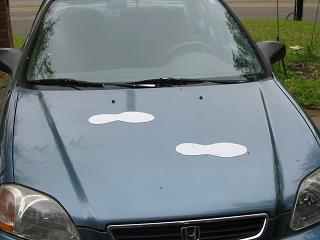He recommends molasses as a biostimulant: 1 pint per acre for broadleaf plants and 1 quart per acre of others. My two beds are about 200 square feet or less than 0.005 acres. Maybe a tablespoon is enough for that.
Hydrogen peroxide as a healing spray. He recommends 8 ounces of 3 percent solution per gallon of water. In my quart-size spray bottle, that's a shotglass of H202.
Vinegar has many useful purposes. One tablespoon per gallon for foliar feeding. It is acidic and good for acid-loving plants. So heavy concentrations can actually be used to kill weeds. Garrett discuss many uses for vinegar.
He offers many other suggestions for foliar feeding, but the ones I've listed are cheap, quick, and readily available. I don't need to make compost tea or purchase fish emulsion. However, thanks to a Christmas present from my parent I have some of the Garden Guy's Extreme Juice. I began foliar feeding with it this past week. Too early to tell how much of an effect it has. I'll have to continue weekly feedings. I'm especially interested in how my persimmon tree and blueberry bushes come along this year.
One other interesting recipe is for pesticide. You can use garlic spray or garlic/pepper tea. Use the liquid of two garlic bulbs and two hot peppers to a gallon of water. Then use no more than a quarter cup of that per gallon to spray. The pepper can kill some small insects--including the good guys. So this will be a good spray on the front lawn when it is swarming with white flies.
His primary focus for pest control is biodiversity. Healthy plants and plenty of competition will keep most harmful bugs in check. When that doesn't work, his drug of choice is diatomaceous earth.
The Dirt Doctor's focus is mostly on enhancing the soil through adding organic matter and promoting microscopic life. He talks some about pH. The most surprising position he takes is that NPK doesn't matter. This utterly flies in the face of most of the things I've read. Most of those things were not strictly organic. He contends healthy soil with lots of good microscopic life, plenty of worms and a good bit of oxygen. He claims oxygen is what is most deficient in most soil. It makes sense, if the air can get in, the mycorrhizal fungi can help extract (by hosting bacteria) nitrogen from it and help it get into plant roots.
He has me convinced enough to give it a try.

1 comment:
For aphids and other soft bodied insects I use a mixture of one small orange pulverized in the blender (skin and all), a couple of drops of mild dishwashing soap, and water to fill a quart spray bottle. The orange oil does the trick, so you could probably just use the peels of a few oranges instead of an entire one.
Post a Comment